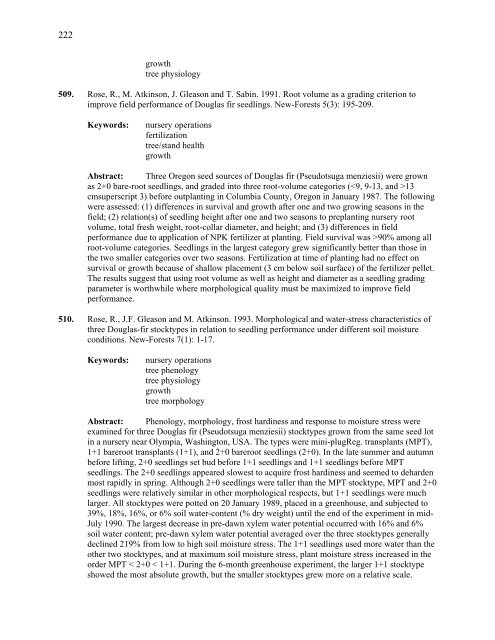IntensIve sIlvIculture - Forest Science Labs - Research Network ...
IntensIve sIlvIculture - Forest Science Labs - Research Network ...
IntensIve sIlvIculture - Forest Science Labs - Research Network ...
Create successful ePaper yourself
Turn your PDF publications into a flip-book with our unique Google optimized e-Paper software.
222<br />
growth<br />
tree physiology<br />
509. Rose, R., M. Atkinson, J. Gleason and T. Sabin. 1991. Root volume as a grading criterion to<br />
improve field performance of Douglas fir seedlings. New-<strong>Forest</strong>s 5(3): 195-209.<br />
Keywords: nursery operations<br />
fertilization<br />
tree/stand health<br />
growth<br />
Abstract: Three Oregon seed sources of Douglas fir (Pseudotsuga menziesii) were grown<br />
as 2+0 bare-root seedlings, and graded into three root-volume categories (13<br />
cmsuperscript 3) before outplanting in Columbia County, Oregon in January 1987. The following<br />
were assessed: (1) differences in survival and growth after one and two growing seasons in the<br />
field; (2) relation(s) of seedling height after one and two seasons to preplanting nursery root<br />
volume, total fresh weight, root-collar diameter, and height; and (3) differences in field<br />
performance due to application of NPK fertilizer at planting. Field survival was >90% among all<br />
root-volume categories. Seedlings in the largest category grew significantly better than those in<br />
the two smaller categories over two seasons. Fertilization at time of planting had no effect on<br />
survival or growth because of shallow placement (3 cm below soil surface) of the fertilizer pellet.<br />
The results suggest that using root volume as well as height and diameter as a seedling grading<br />
parameter is worthwhile where morphological quality must be maximized to improve field<br />
performance.<br />
510. Rose, R., J.F. Gleason and M. Atkinson. 1993. Morphological and water-stress characteristics of<br />
three Douglas-fir stocktypes in relation to seedling performance under different soil moisture<br />
conditions. New-<strong>Forest</strong>s 7(1): 1-17.<br />
Keywords: nursery operations<br />
tree phenology<br />
tree physiology<br />
growth<br />
tree morphology<br />
Abstract: Phenology, morphology, frost hardiness and response to moisture stress were<br />
examined for three Douglas fir (Pseudotsuga menziesii) stocktypes grown from the same seed lot<br />
in a nursery near Olympia, Washington, USA. The types were mini-plugReg. transplants (MPT),<br />
1+1 bareroot transplants (1+1), and 2+0 bareroot seedlings (2+0). In the late summer and autumn<br />
before lifting, 2+0 seedlings set bud before 1+1 seedlings and 1+1 seedlings before MPT<br />
seedlings. The 2+0 seedlings appeared slowest to acquire frost hardiness and seemed to deharden<br />
most rapidly in spring. Although 2+0 seedlings were taller than the MPT stocktype, MPT and 2+0<br />
seedlings were relatively similar in other morphological respects, but 1+1 seedlings were much<br />
larger. All stocktypes were potted on 20 January 1989, placed in a greenhouse, and subjected to<br />
39%, 18%, 16%, or 6% soil water-content (% dry weight) until the end of the experiment in mid-<br />
July 1990. The largest decrease in pre-dawn xylem water potential occurred with 16% and 6%<br />
soil water content; pre-dawn xylem water potential averaged over the three stocktypes generally<br />
declined 219% from low to high soil moisture stress. The 1+1 seedlings used more water than the<br />
other two stocktypes, and at maximum soil moisture stress, plant moisture stress increased in the<br />
order MPT < 2+0 < 1+1. During the 6-month greenhouse experiment, the larger 1+1 stocktype<br />
showed the most absolute growth, but the smaller stocktypes grew more on a relative scale.
















